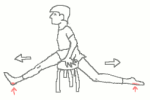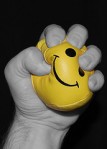 I hung some gymnastic rings over a rafter in my garage. I wish they were in the living room because I really like them. Whenever I walk by I like to swing a little back and forth, left and right, in circles, with one or two arms. I think part of the reason I like swinging on the rings so much is that my ancestors probably engaged in lots of similar activity when they lived in trees.
I hung some gymnastic rings over a rafter in my garage. I wish they were in the living room because I really like them. Whenever I walk by I like to swing a little back and forth, left and right, in circles, with one or two arms. I think part of the reason I like swinging on the rings so much is that my ancestors probably engaged in lots of similar activity when they lived in trees.
 The other morning I was taking a walk with my one year old daughter strapped to my chest. She was facing me and I had my hands around her low back.
When she is not fast asleep she likes to look around to check out what’s going on in the hood. One of the things I have noticed about babies is that a huge percentage of their movements in the first year . . .
The other morning I was taking a walk with my one year old daughter strapped to my chest. She was facing me and I had my hands around her low back.
When she is not fast asleep she likes to look around to check out what’s going on in the hood. One of the things I have noticed about babies is that a huge percentage of their movements in the first year . . .
 I have previously posted about some studies addressing the relationship between flexibility and running economy. The studies find that less flexibility correlates with greater running economy. The reason is probably that that elastic recoil of muscle and tendon is an important contributor to running power. Just as a golf ball will bounce higher and longer than a squash ball, a stiff runner will
I have previously posted about some studies addressing the relationship between flexibility and running economy. The studies find that less flexibility correlates with greater running economy. The reason is probably that that elastic recoil of muscle and tendon is an important contributor to running power. Just as a golf ball will bounce higher and longer than a squash ball, a stiff runner will
 Have you ever noticed that toddlers are champion squatters? They sit into the deep squat with total ease, hang out there for a while, play with some toys, look around aimlessly, eat some dirt, poop their pants, get up again, walk three steps, and then drop down smooth as silk into the deep squat again. And then over and over again, like twenty times in ten minutes, with no sense of effort or fatigue at all....
Have you ever noticed that toddlers are champion squatters? They sit into the deep squat with total ease, hang out there for a while, play with some toys, look around aimlessly, eat some dirt, poop their pants, get up again, walk three steps, and then drop down smooth as silk into the deep squat again. And then over and over again, like twenty times in ten minutes, with no sense of effort or fatigue at all....
I am not a big fan of running. I’ve always played ball sports like tennis, squash and soccer. So I will run, but only when I’m chasing after a ball. Otherwise, what’s the point? I honestly cannot understand how people slog away mile after mile on their feet or on a bike or in a pool doing the same thing over and over again. And they seem to like it! Whenever I hear that someone is a great runner, I always think - wow that would be useful on the soccer field....
Read More If you can dream it you can do it! Well, according to a recent study, maybe not so much, at least when your dream is to rehabilitate an arm weakened by stroke.
I have written several times on this blog about how imagery and visualization can be used to build coordination and physical skills. For example . . .
If you can dream it you can do it! Well, according to a recent study, maybe not so much, at least when your dream is to rehabilitate an arm weakened by stroke.
I have written several times on this blog about how imagery and visualization can be used to build coordination and physical skills. For example . . .
 I've decided to add a new feature to the blog - a (hopefully) weekly showcase of a video of a some excellent movement, along with some brief commentary about why I found it inspiring, or interesting, or exemplary of some of the principles I talk about on this blog. To start off, here is a beautiful video of man spear fishing while holding his breath for several minutes deep under the ocean.
I've decided to add a new feature to the blog - a (hopefully) weekly showcase of a video of a some excellent movement, along with some brief commentary about why I found it inspiring, or interesting, or exemplary of some of the principles I talk about on this blog. To start off, here is a beautiful video of man spear fishing while holding his breath for several minutes deep under the ocean.
 Time for another guest post from Paul Ingraham, his second. Paul recently contacted me to say he wants to do a post that "criticizes the idea of trigger points,” which is interesting, because he’s written a whole book about trigger points. I told him whatever you do, just make sure the title of the post sounds like a Chuck Norris movie.
Time for another guest post from Paul Ingraham, his second. Paul recently contacted me to say he wants to do a post that "criticizes the idea of trigger points,” which is interesting, because he’s written a whole book about trigger points. I told him whatever you do, just make sure the title of the post sounds like a Chuck Norris movie.
 In parts one and two of this series I discussed Barrett Dorko’s interesting theory that ideomotion can prevent and reduce many sources of chronic pain. To briefly summarize, ideomotion is a non voluntary movement prompted by mental activity. All mental and emotional activity is coupled . . .
In parts one and two of this series I discussed Barrett Dorko’s interesting theory that ideomotion can prevent and reduce many sources of chronic pain. To briefly summarize, ideomotion is a non voluntary movement prompted by mental activity. All mental and emotional activity is coupled . . .
 I have written previously about how posture and mood are a two way street. For example, feeling bold can cause you to adopt an expansive posture, and adopting an expansive posture can make you feel bold. This an example of embodied cognition - the brain’s use of physical movements as part of its process of forming mental representations. There are numerous . . .
I have written previously about how posture and mood are a two way street. For example, feeling bold can cause you to adopt an expansive posture, and adopting an expansive posture can make you feel bold. This an example of embodied cognition - the brain’s use of physical movements as part of its process of forming mental representations. There are numerous . . .
 I did an interview! With Will Stewart.
Will is the owner of 3-D Optimum Performance and he just decided to start interviewing everyone in sight who thinks the nervous system is the primary target for manual therapy or athletic training.
I did an interview! With Will Stewart.
Will is the owner of 3-D Optimum Performance and he just decided to start interviewing everyone in sight who thinks the nervous system is the primary target for manual therapy or athletic training.
 In a previous post I introduced the concept of ideomotion, which is a non voluntary movement prompted by mental activity. In this post I’ll discuss Barrett Dorko’s interesting theory that ideomotion may play a role in reducing and preventing some common sources of chronic pain. Here is my (hopefully accurate) interpretation of Dorko’s theory in a nutshell....
In a previous post I introduced the concept of ideomotion, which is a non voluntary movement prompted by mental activity. In this post I’ll discuss Barrett Dorko’s interesting theory that ideomotion may play a role in reducing and preventing some common sources of chronic pain. Here is my (hopefully accurate) interpretation of Dorko’s theory in a nutshell....
 Excessive sitting will shorten your hip flexors. I have read this sentence many times. What I have never read is a citation to supporting evidence at the end of the sentence. It’s one of those claims that no one ever questions, like you should drink eight glasses of water a day. Let’s see how it stand up to some critical inquiry....
Excessive sitting will shorten your hip flexors. I have read this sentence many times. What I have never read is a citation to supporting evidence at the end of the sentence. It’s one of those claims that no one ever questions, like you should drink eight glasses of water a day. Let’s see how it stand up to some critical inquiry....
 Ideomotion is a movement that occurs as a result of mental activity, but independently of conscious volition. This makes it a very mischievous movement. Although most people have never heard of ideomotion, it is the likely explanation for a wide variety of interesting phenomena, such as ouija boards, cold reading, poker tells, various scams and magic tricks, and certain claims of supernatural power
Ideomotion is a movement that occurs as a result of mental activity, but independently of conscious volition. This makes it a very mischievous movement. Although most people have never heard of ideomotion, it is the likely explanation for a wide variety of interesting phenomena, such as ouija boards, cold reading, poker tells, various scams and magic tricks, and certain claims of supernatural power
 Ever notice that athletes sometimes wear medical tape on various parts of their body during competition? During the 2008 Olympic games, numerous athletes, including volleyball star Kerri Walsh, wore interesting formations of "kinesiotape" on their shoulders, knees, and backs. David Beckham and Serena Williams are also fans of the tape. Perhaps this is just because David and Serena are fashionable types - they are bored with tattoos and looking for the latest in alternative body adornment.
Ever notice that athletes sometimes wear medical tape on various parts of their body during competition? During the 2008 Olympic games, numerous athletes, including volleyball star Kerri Walsh, wore interesting formations of "kinesiotape" on their shoulders, knees, and backs. David Beckham and Serena Williams are also fans of the tape. Perhaps this is just because David and Serena are fashionable types - they are bored with tattoos and looking for the latest in alternative body adornment.
 A few weeks ago I posted a twenty five minute audio lesson on improving the squat. Below is a link to volume two. If you haven’t done volume one already, I would highly recommend that you do that before moving to volume two. On the other hand, I think I saw Godfather Two before the first one, and the results were excellent.
A few weeks ago I posted a twenty five minute audio lesson on improving the squat. Below is a link to volume two. If you haven’t done volume one already, I would highly recommend that you do that before moving to volume two. On the other hand, I think I saw Godfather Two before the first one, and the results were excellent.
In sports, one of the most important (and completely overlooked) keys to performance is the processing of visual information. I just came across a study that helps demonstrate this point in an interesting way.
Read More
